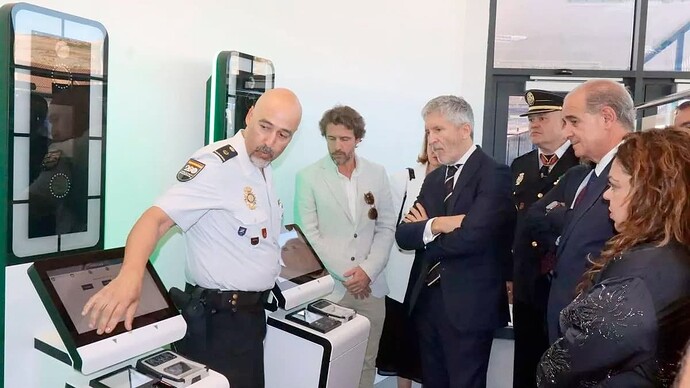Interior begins the installation of the smart border system with Gibraltar without waiting for an agreement on the colony
The Entry Exit System approved by the EU for non-EU citizens incorporates cameras and biometric facial controls.
The US and the United Kingdom are suspicious of the collection of data from their military personnel stationed in the 27 and their surroundings.
Conditions to enter Spain from Gibraltar and non-EU countries.
The Ministry of the Interior has begun the installation of a complex smart border system at the entrances and exits of Gibraltar in accordance with the conditions of the Entry Exit System (EES), approved by the European Union (EU) to control citizens, especially to non-EU citizens, at the external borders of the 27.
Although we are still waiting for a possible agreement between the EU and the United Kingdom to enable the free movement of people, capital, goods and services to and from the British colony, which would lead to dismantling the entire system, the Interior has chosen to maintain its plans to control that hot spot. The mechanism includes a system of cameras and biometric facial recognition with a dual purpose: to speed up the procedures for moving from one territory to another – especially for the 15,000 cross-border workers – and to raise security levels.
The installation of the EES computer equipment in the Gate began weeks ago and next Monday, the 15th, the assembly of the new accesses will begin, practically identical to those inaugurated in Ceuta last Wednesday, July 10, by the Minister of Interior, Fernando Grande-Marlaska, to control entries and exits to and from Morocco through the El Tarajal border.
Among the improvements introduced in Ceuta are closed circuit television, automatic license plate identification systems, people detection equipment, metal arches, luggage scanners, identification systems by rapid fingerprint search, manual metal detectors and security control systems. accesses, according to Interior.
The launch of these same teams between La Línea and Gibraltar will occur in parallel to the contacts that the governments of Spain and the United Kingdom, with the Spanish José Manuel Albares and the new British Foreign Minister, the Labor Party David Lammy, have resumed after the elections on the 5th in that last country. These conversations are preparatory to those that will have to be resumed by the government of the United Kingdom and the European Commission, which has yet to elect its new officials in this matter, also after the European elections, held between June 6 and 9.
The purpose of this dialogue is the incorporation of Gibraltar into the European Schengen area, although the intention of the Llanista authorities and the United Kingdom is to maintain a privileged status, similar to the current one, with a tax rate significantly lower than that of its Spanish neighbors and with ad hoc adaptation to EU directives in practically all areas.
For the disappearance of the Gate to be possible, understood as the space where EU customs and security controls are carried out, these should be moved to the port and airport of Gibraltar as they are the new entry doors to the EU. For this reason, the investment now undertaken by the Interior to install the EES on the dividing line between Gibraltar and La Línea may soon have an expiration date and the entire equipment may have to be dismantled and moved.
EU requirements
As long as Gibraltar remains in its current situation, citizens of the United Kingdom, along with those of other nationalities arriving at the Rock, must continue to comply with a series of requirements at the Gate to enter Spain: carry a passport, justify the purpose of the visit and the conditions of your stay (a hotel reservation, for example), as well as demonstrating sufficient means of subsistence. Gibraltarians are the exception, as they enjoy a unique status and pass by simply showing their ID (Identity Card).
Biometric facial controls to identify each individual are intended to speed up this entire process, although in some cases, such as that of members of the British and US armed forces (who so frequently stop at the Gibraltar military base) they can become an inconvenience.
The governments of both countries, according to sources familiar with the matter consulted by Europa Sur, have shown their misgivings about the data that the EU authorities may collect on the members of their military forces when they cross the external borders of the EU. In the case of Gibraltar there are around a thousand British soldiers trapped on the Rock since, to enter Spain, they must meet the requirements that the EU demands of citizens of third countries.
Ceuta serves as a reference. During his visit to the autonomous city, Grande-Marlaska indicated that the El Tarajal border will be intelligent “before the end of the year.” “After six years of work and more than 22 million euros of investment, Ceuta has a modern border post adapted to the needs and requirements of the European Union (EU),” said the Minister of the Interior.
Changes in Gibraltar
In September 2023, the Government of Gibraltar also announced “a major remodeling of the pedestrian and vehicle entrances to Gibraltar on the land border with Spain” by installing “a battery of automatic gates.”
“The remodeling had been delayed while waiting for the negotiation of a treaty with the European Union,” the Llanos authorities indicated in a statement, stressing that this will achieve “more fluid access for people in the event that the treaty is not reaches a negotiated result”, that is, if the Fence does not finally disappear as a result of the talks between the EU and the United Kingdom.
Translated from - Interior inicia la instalación del sistema de frontera inteligente con Gibraltar sin esperar a un acuerdo sobre la colonia
